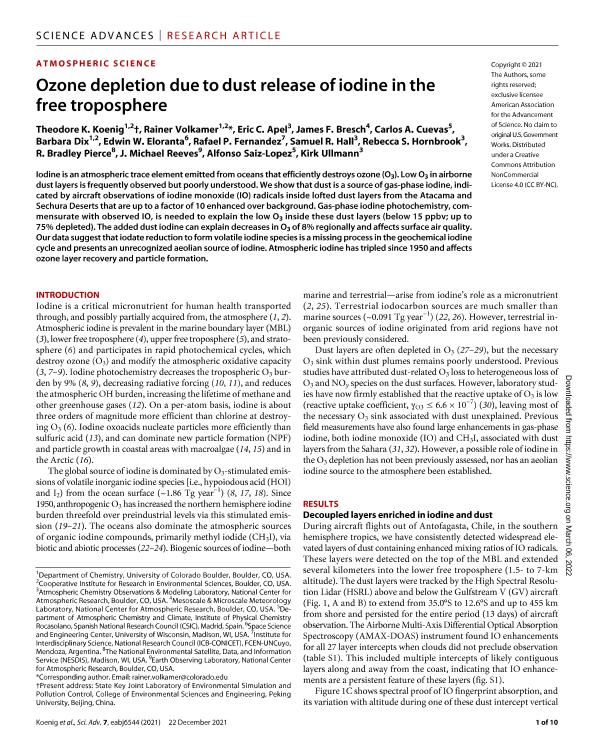Artículo
Ozone depletion due to dust release of iodine in the free troposphere
Koenig, Theodore K.; Volkamer, Rainer; Apel, Eric C.; Bresch, James F.; Cuevas, Carlos A.; Dix, Barbara; Eloranta, Edwin W.; Fernandez, Rafael Pedro ; Hall, Samuel R.; Hornbrook, Rebecca S.; Pierce, R. Bradley; Reeves, J. Michael; Saiz López, Alfonso; Ullmann, Kirk
; Hall, Samuel R.; Hornbrook, Rebecca S.; Pierce, R. Bradley; Reeves, J. Michael; Saiz López, Alfonso; Ullmann, Kirk
 ; Hall, Samuel R.; Hornbrook, Rebecca S.; Pierce, R. Bradley; Reeves, J. Michael; Saiz López, Alfonso; Ullmann, Kirk
; Hall, Samuel R.; Hornbrook, Rebecca S.; Pierce, R. Bradley; Reeves, J. Michael; Saiz López, Alfonso; Ullmann, Kirk
Fecha de publicación:
12/2021
Editorial:
Science Advances is the American Association for the Advancement of Science
Revista:
Science Advances
ISSN:
2375-2548
Idioma:
Inglés
Tipo de recurso:
Artículo publicado
Clasificación temática:
Resumen
Iodine is an atmospheric trace element emitted from oceans that efficiently destroys ozone (O3). Low O3 in airborne dust layers is frequently observed but poorly understood. We show that dust is a source of gas-phase iodine, indicated by aircraft observations of iodine monoxide (IO) radicals inside lofted dust layers from the Atacama and Sechura Deserts that are up to a factor of 10 enhanced over background. Gas-phase iodine photochemistry, commensurate with observed IO, is needed to explain the low O3 inside these dust layers (below 15 ppbv; up to 75% depleted). The added dust iodine can explain decreases in O3 of 8% regionally and affects surface air quality. Our data suggest that iodate reduction to form volatile iodine species is a missing process in the geochemical iodine cycle and presents an unrecognized aeolian source of iodine. Atmospheric iodine has tripled since 1950 and affects ozone layer recovery and particle formation.
Palabras clave:
OZONE DEPLETION
,
DUST RELEASE
,
TORERO
,
IODINE CHEMISTRY
Archivos asociados
Licencia
Identificadores
Colecciones
Articulos(ICB)
Articulos de INSTITUTO INTERDISCIPLINARIO DE CIENCIAS BASICAS
Articulos de INSTITUTO INTERDISCIPLINARIO DE CIENCIAS BASICAS
Citación
Koenig, Theodore K.; Volkamer, Rainer; Apel, Eric C.; Bresch, James F.; Cuevas, Carlos A.; et al.; Ozone depletion due to dust release of iodine in the free troposphere; Science Advances is the American Association for the Advancement of Science; Science Advances; 7; 52; 12-2021; 1-11
Compartir
Altmétricas



